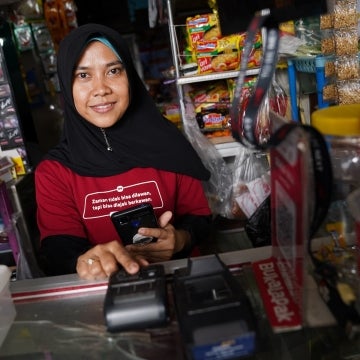Our lives have also become more digital through shopping, social interactions, news, and information gathering, to name just a few.
A burgeoning amount of personal data is now being produced daily. The total amount of data created, captured, copied, and consumed globally is projected to keep increasing significantly, having already risen to 149 zettabytes in 2024 from just 2 zettabytes in 2010, according to Statista. For perspective, each zettabyte of data would take one billion one-terabyte hard drives, which are each equivalent to storing 6.5 million documents.
Due to the sheer volume of personal data and the seemingly unstoppable process of digitization, the concept of collateral is also evolving.
We are already seeing the early stages of this future. For example, data collected from simple transactions, such as everyday grocery shopping, can now be harnessed to assess creditworthiness.
Data could be the new collateral
For the longest time, lending has relied heavily on physical collateral. This model, however, has excluded many potential borrowers, particularly micro, small, and medium enterprises (MSMEs), which make up 90 percent of businesses and more than 50 percent of employment worldwide. They often lack the necessary collateral to secure loans that could support their resilience and growth. About 80 percent of loans that require collateral ask for real property, according to a World Bank report. However, around 75 percent of small and medium enterprises (SMEs) only own movable assets, like equipment and inventory.
Innovation will be critical to remove the barriers currently limiting small businesses’ access to finance.
A recent CGAP study into alternative credit scoring shows that assessing transactional data from micro and small enterprises (MSEs) and gig platform workers can predict creditworthiness as effectively as credit history. Data trails such as sales, expenses, orders, and invoices can provide a reliable record of financial behavior. Combining both transactional data and credit history enhances prediction accuracy even further, helping more small businesses secure loans, without increasing risks to the finance provider. Transactional data also allows lenders to tailor loans, including by adjusting repayment terms to match the borrower’s cash flow volatility.
With rapid advances in artificial intelligence (AI) and ever more data being generated, the potential to further improve such credit scoring models is immense and so far, we have only seen the tip of the iceberg.
Cash-flow-based lending, particularly through embedded finance models that integrate financial services into non-financial platforms or products, has also shown significant promise in supporting micro-retailers by providing them with accessible and tailored financial services.
CGAP looked at various models that fintechs are using to provide loans for micro-retailers. In Latin America, for instance, a large e-commerce platform reported that they provided credit to sellers based on their transaction data. Around 50 percent of businesses that got credit said they had been unable to get it elsewhere, and more than 60 percent of these reported that their business had grown as a result.
The role of data will become more significant as more countries adopt open finance. Through open finance ecosystems, customers can give consent to let financial institutions use their data to provide enhanced services and develop innovative business models.
Over USD $10 billion in loans have been disbursed through the Account Aggregator Framework, India’s open finance ecosystem, since its launch in September 2021. Remarkably, half of this total lending occurred in the last six months of 2024, and transactional data such as bank statements were primarily used to assess creditworthiness.
A new golden age for empowering consumers with their data
This transformation might be arriving just in time. A staggering 1.2 billion young people across emerging economies are expected to reach working age over the next decade, according to World Bank estimates.
This transformation could also change the futures of women-led small enterprises in low-income countries, which often struggle with limited financing because of a lack of collateral or gender norms that restrict opportunities. While traditional banks view them as risky, digital data can change their fortunes. By using their data, these businesses can secure loans tailored to their needs, enabling them to purchase better equipment and hire additional staff.
This has been seen through the World Bank’s Women Entrepreneurs Finance Initiative (We-Fi), which partnered with a commercial bank in Nigeria to provide cash-flow-based loans to SMEs without requiring physical collateral. This innovative product yielded positive repayment trends, with the bank reporting a 99 percent repayment rate for its cash flow-based loan portfolio over the period of 32 months.
The potential for change is immense, and we are on the brink of a new era that could empower the underserved and reshape economic landscapes. To harness the potential of digital data, more investment is needed in three areas:
Inclusive digital public infrastructure (DPI)
To ensure all citizens benefit from future data-driven financial developments, governments should focus on creating inclusive digital public infrastructure (DPI), especially for rural populations and women.
Also, while the use of alternative credit scoring based on transaction data is increasingly accepted, especially by financial regulators in high-income countries, regulators in emerging markets that implement open finance schemes will need to consider enabling the use of alternative data in credit scoring models, provided data protection laws are strong and enforced and models avoid discrimination and are explainable.
Enhanced consumer protection and data privacy
As financial services powered by digital data expand, governments and financial services providers need to double down on consumer protection, data privacy, cybersecurity measures, and customer education. These protections will safeguard the interests of inexperienced users and ensure the reliability and security of financial transactions.
We will also need to foster collaboration between different regulatory agencies, both financial and non-financial, to ensure a suitable regulatory approach that both fosters innovation and safeguards consumers.
Gender-disaggregated data collection
For women to fully reap these advantages, it is essential to collect and analyze gender-disaggregated data. This will help women directly benefit from data-driven innovation, bridging the gap in financial services for women and enabling them to access appropriately priced and tailored financial products.
By taking these steps, we can help ensure this next wave of disruption creates a more inclusive and equitable financial system that leverages the power of digital data to uplift marginalized and underserved communities.
An excerpt from this article first appeared in The Banker.



